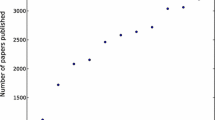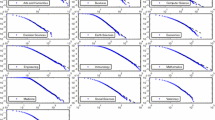Abstract
The first-citation distribution, i.e. the cumulative distribution of the time period between publication of an article and the time it receives its first citation, has never been modelled by using well-known informetric distributions. An attempt to this is given in this paper. For the diachronous aging distribution we use a simple decreasing exponential model. For the distribution of the total number of received citations we use a classical Lotka function. The combination of these two tools yield new first-citation distributions.
The model is then tested by applying nonlinear regression techniques. The obtained fits are very good and comparable with older experimental results of Rousseau and of Gupta and Rousseau. However our single model is capable of fitting all first-citation graphs, concave as well as S-shaped; in the older results one needed two different models for it.
Our model is the function
Here γ is the fraction of the papers that eventually get cited, t1 is the time of the first citation, a is the aging rate and α is Lotka's exponent. The combination of a and α in one formula is, to the best of our knowledge, new. The model hence provides estimates for these two important parameters.
Similar content being viewed by others
References
Egghe, L., I. K. Ravichandra Rao (1992), Citation age data and the obsolescence function: fits and explanations. Information Processing and Management 28(2): 201–217.
Egghe, L., R. Rousseau (1990), Introduction to Informetrics. Quantitative Methods in Library, Documentation and Information Science, Elsevier, Amsterdam.
GlÅnzel, W. (1992), On some stopping times of citation processes. From theory to indicators. Information Processing and Management, 28: 53–60.
GlÅnzel, W., U. Schoepflin (1995), A bibliometric study on ageing and reception processes of scientific literature. Journal of Information Science, 21: 37–53.
Gupta, B.M., R. Rousseau (1999), Further investigations into the first-citation process: the case of population genetics. Libres, 9(2), aztec.lib.utk.edu/libres/libre9n2/fc.htm.
Matricciani, E. (1991), The probability distribution of the age of references in engineering papers. IEEE Transactions of Professional Communication, 34: 7–12.
Moed, H. F., A. F. J. Van Raan (1986), Cross-field impact and impact delay of physics departments. Czechoslovak Journal of Physics, B36: 97–100.
Motylev, V. M. (1981), Study into the stochastic process of change in the literature citation pattern and possible approaches to literature obsolescence estimation. International Forum on Information and Documentation, 6: 3–12.
Rousseau, R. (1994), Double exponential models for first-citation processes. Scientometrics, 30: 213–227.
Schubert, A., W. GlÅnzel (1986), Mean response time — a new indicator of journal citation speed with application to physics journals. Czechoslovak Journal of Physics, B36: 121–125.
Author information
Authors and Affiliations
Rights and permissions
About this article
Cite this article
Egghe, L. A Heuristic Study of the First-Citation Distribution. Scientometrics 48, 345–359 (2000). https://doi.org/10.1023/A:1005688404778
Issue Date:
DOI: https://doi.org/10.1023/A:1005688404778




